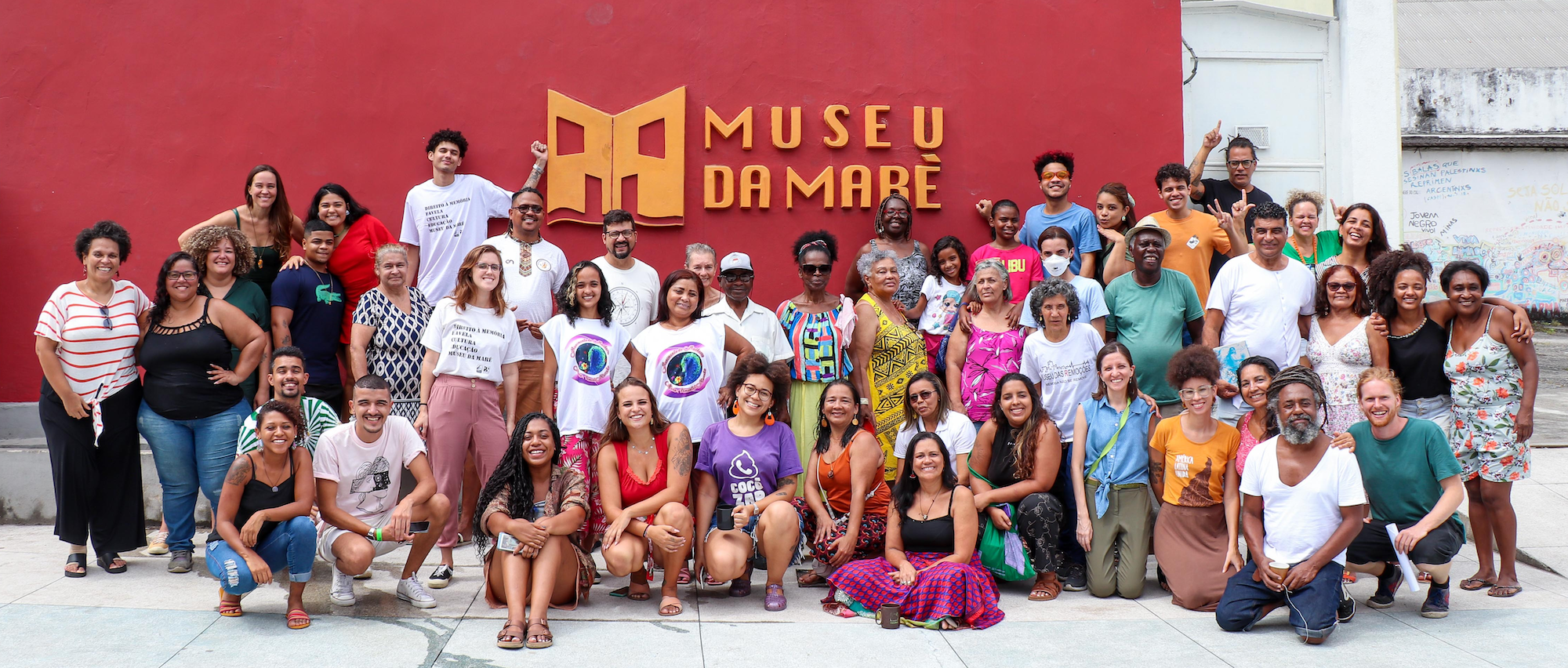
On June 17, 2023, Rio de Janeiro’s Sustainable Favela Network (SFN)* launched its Favela Climate Memory Exhibition, the culmination of five day-long climate memory circles held by favela community museums between January and March. This series of articles explores the dynamics of each memory circle which makes up the exhibition, with this article introducing the first discussion circle, held on January 28 by the Maré Museum. Developed by the SFN’s Culture and Memory Working Group, the project was realized by community museums, technical allies, and community organizers from favelas across Greater Rio.
The Sustainable Favela Network’s Climate Memory Circles are community events aimed at recovering and recording the memories and stories of long-time residents of Rio de Janeiro’s favelas in relation to the environment so as to envision ways to prepare for climate changes to come. Though still rarely discussed, the memory circles showed that climate change is very much present in the daily lives and concerns of favela residents.
Each memory circle event took place over the course of a day, with residents invited by the museums to take part in a series of discussions designed to focus on and dig deeper into the climate change theme. Residents shared their views and experiences of climate change, recovered memories about the settling of their communities and the relationship of this settlement period with the surrounding environment, discussed the relationship between climate impacts and housing rights, and explored solutions and organizing by residents, highlighting the mistaken priorities of the State, which tends to see forced evictions as the solution.
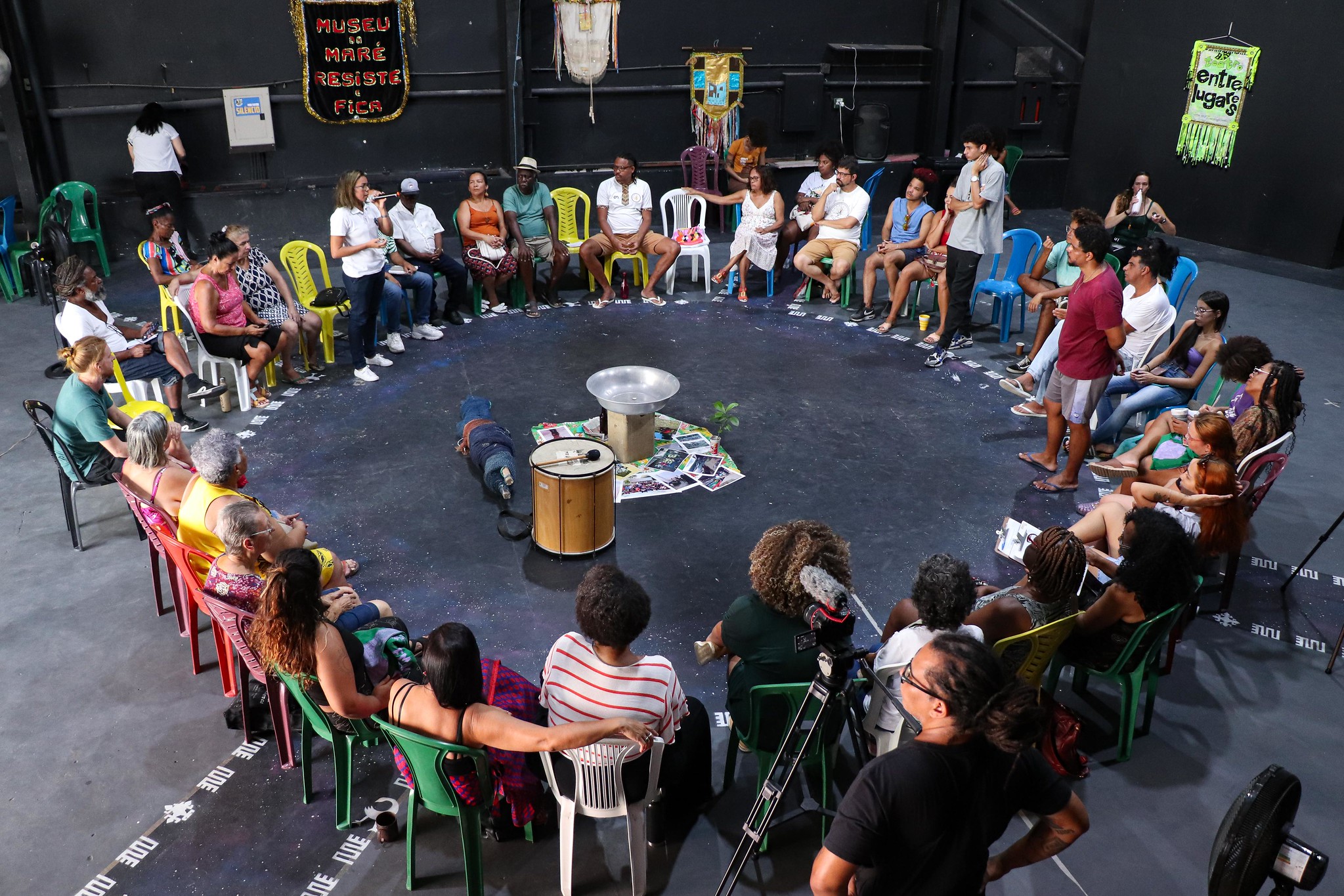
On January 28, 2023, the first event of the series took place. The Maré Climate Memory Circle was hosted by the Maré Museum and attended by 57 people, among them some of the oldest residents of the favelas of Complexo da Maré, as well as youth, and representatives of important Maré civil society collectives such as the Center for Studies and Solidarity Actions of Maré (CEASM), Cocôzap, Muda Maré, and Raízes da Mata. Favela museums from other communities were also represented.
A photography exhibition at the entrance to the museum gave attendees a chance to view historic black and white images documenting the formation of Complexo da Maré. The exhibition showed Maré’s original stilt houses and aerial images from the 1990s when Maré was officially recognized as a neighborhood, despite to this day still not having received the appropriate investment or public services.
The event kicked off with two engaging activities. The first, proposed by Brenda Vitória, a young environmental activist, had attendees form groups of three, introduce themselves and share interesting facts about their lives. Participants rotated between groups so as to have everyone interact and foster connection. Following this, Marilene Nunes from the Maré Museum invited everyone to take part in the second playful activity. The names of those who had brought in personal objects which carry emotional memories and interact with the climate theme were drawn from a bowl to be presented to the group.
There were many remarkable presentations during this activity, including from Evelina Barth, a resident of Complexo da Maré for over 30 years, who moved everyone with her account. She shared her past of extreme poverty experienced by her and her peers and the lack of access to basic survival items such as medication, which culminated in her work with medicinal plants. She has been a reference in the favela for decades and is much sought after in the community.
“We were invited to take courses to be able to work with medicinal plants. And so we started our work in Maré, in Vila Pinheiro. Then we also got some help, so we could do it in a simple, homemade way, you know? And we’ve been doing that ever since. It’s my favorite job in the world. Herbal medicine, using medicinal plants, is like a preventive tea, but it really helps people to get better.” — Evelina Barth
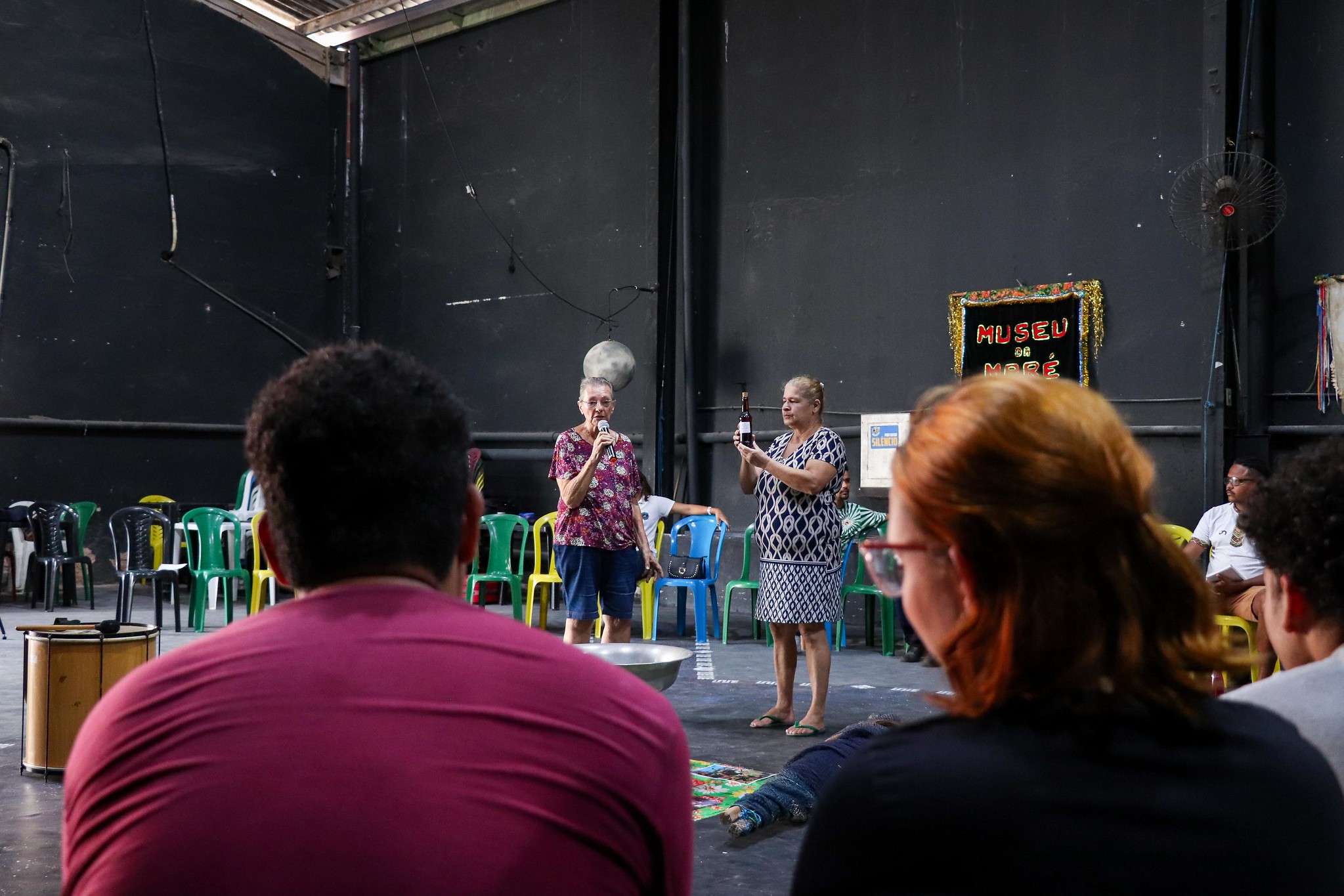
The evictions that took place in the 1970s in Complexo da Maré emerged as a prominent theme in the discussion; during the 1970s, 450 families were removed from Praia de Inhaúma in Maré and taken to Antares, a favela in Santa Cruz, in Rio de Janeiro’s extreme West Zone, some two hours away. Leonardo Ribeiro de Sousa, a history student and researcher from Antares, took part in the circle as a representative of the Historic Orientation and Research Nucleus of Santa Cruz (NOPH). In his talk, he contextualized the historic eviction process, which is intimately linked to his own life story. He spoke, showing the notebook with his research notes on the process of how the Antares favela was occupied.
“Within this process, there was the forced eviction of 450 families that were removed from Maré, from Praia de Inhaúma in March 1975. My mother was among them; she left here from Praia de Inhaúma… Once, I came here to Maré and took a photo of the house on stilts they have there [inside the museum] and showed it to my mother. She cried, and I was really moved… I didn’t experience [the eviction process]; I was already born in Antares. But this triggered a huge emotional memory in me, from the stories my mother tells about what happened here. My brother fell from one of the walkways [between the stilts, which served as passages over the waters of the Guanabara Bay], and there was a commotion of the entire community to rescue my brother. So, I am researching this highly aggressive eviction process that links Maré and Antares. That’s why I made a point of putting this research [in the bowl to share with the circle]. I am very happy to be here, as a representative from the NOPH museum, as a SFN guest, and here in Maré, where my family came from, a part of my roots. So, I really appreciate it.” — Leonardo Ribeiro de Sousa
What Is Climate Change?
Following the emotional introduction session, the cycle of four conversation circles and collective construction on the themes proposed in each one began. In the first circle—entitled “What is climate change?”—Gleison Carvalho, a young Maré resident and circle facilitator, invited those present to contribute with their personal views on climate change and how it affects their community.
Thamires Ribeiro de Oliveira from the Maré Museum team shared an emotional memory of her late paternal grandmother. A Maré resident originally from the Northeast of Brazil, she had a connection with the countryside and medicinal plants. The power of nature always surrounded her family in Maré. In addition, she fondly recalled her childhood in the favela, times when contact with neighbors, caring for each other, and sharing were stronger than they are today.
She also spoke about a striking moment of contact with environmental education, during National Environment Week (SENAMA) which used to happen in the area known as Baixa do Sapateiro. Even as a child with no understanding of the political dimensions the activities promoted, she said she was impacted by the activities, which she remembers to this day.
Luiz Carlos Santiago is a resident of Maré who has been working with and promoting recycling for 20 years. His activism is based on the importance of correct waste disposal, the power of recycling, and how it can generate income for families. He told those present how he started this important environmental work.
“People were unemployed… Professions disappear over time… And then we started to notice that people threw recyclable material away and often didn’t have money to buy bread. They didn’t know that you could sell PET bottles and go to the bakery to buy bread… So many things that we throw away… had economic value. Not had, they have economic value. What we thought of doing was explaining to the community all the value that PET bottles and drinks cans have… that could be channeled to bring resources into the community… For 20 years, we have been generating work and income for people. For 20 years, we have created conditions for people to go to the supermarket, do their shopping, pay their electricity bill, and pay their debts, because we work with recyclable materials. So we need to rethink the issue of garbage, you know? What is garbage?” — Luiz Carlos Santiago
Santiago also presented solutions to the issue of garbage accumulation in the streets of Maré—a long-term issue affecting the area where he lives. He reflected on solid waste management and climate change in the favelas:
“People still haven’t woken up! We need a treatment plant for waste material within Maré. Another thing we need to think about and organize around: people, climate change has already arrived… we are already affected, but we will be [affected] much more because we are close to the sea… And, why doesn’t UFRJ [Federal University of Rio de Janeiro], a research center of excellence in Brazil, the biggest university [in Brazil]… why doesn’t it answer to the community that surrounds it? We need to pressure the university to give us answers… [we have to] demand public policies from the authorities that at least minimize the damage and problems that we will have through climate change.”
Antonio Carlos Vieira was born in Morro do Timbau in Complexo da Maré and is former president of the Morro do Timbau Residents Association. He questioned the distancing of climate change, as if it were something in the future and separate from our own reality. He warned that this process has been ongoing for years and action is needed.
“In the past, in the summer, [when] we had a hot day, you know what used to happen in the late afternoon? A storm would come, rain would fall, and we would shower in the rain, it was a blast. Who gets to experience that these days? I remember in my childhood going almost a month without rain here in Rio de Janeiro, right? Then there’s this issue that greatly impacts our health, you know, the increase in respiratory diseases, increasing cases of cancer. Cancer today is already endemic, nobody talks about it, right? So, we’re seeing an escalation of problems that we need to be very alert to. There’s the issue of rising sea levels, but there are others. There are other issues already present in our daily lives that we have to be aware of. Global warming and climate change are already happening in our lives. When we were kids, we barely had a fan at home. Nowadays, who can sleep without an air conditioner? So, I mean, these are elements that we are seeing, that are already impacting our lives and that we need to be very alert to.” — Antonio Carlos Vieira
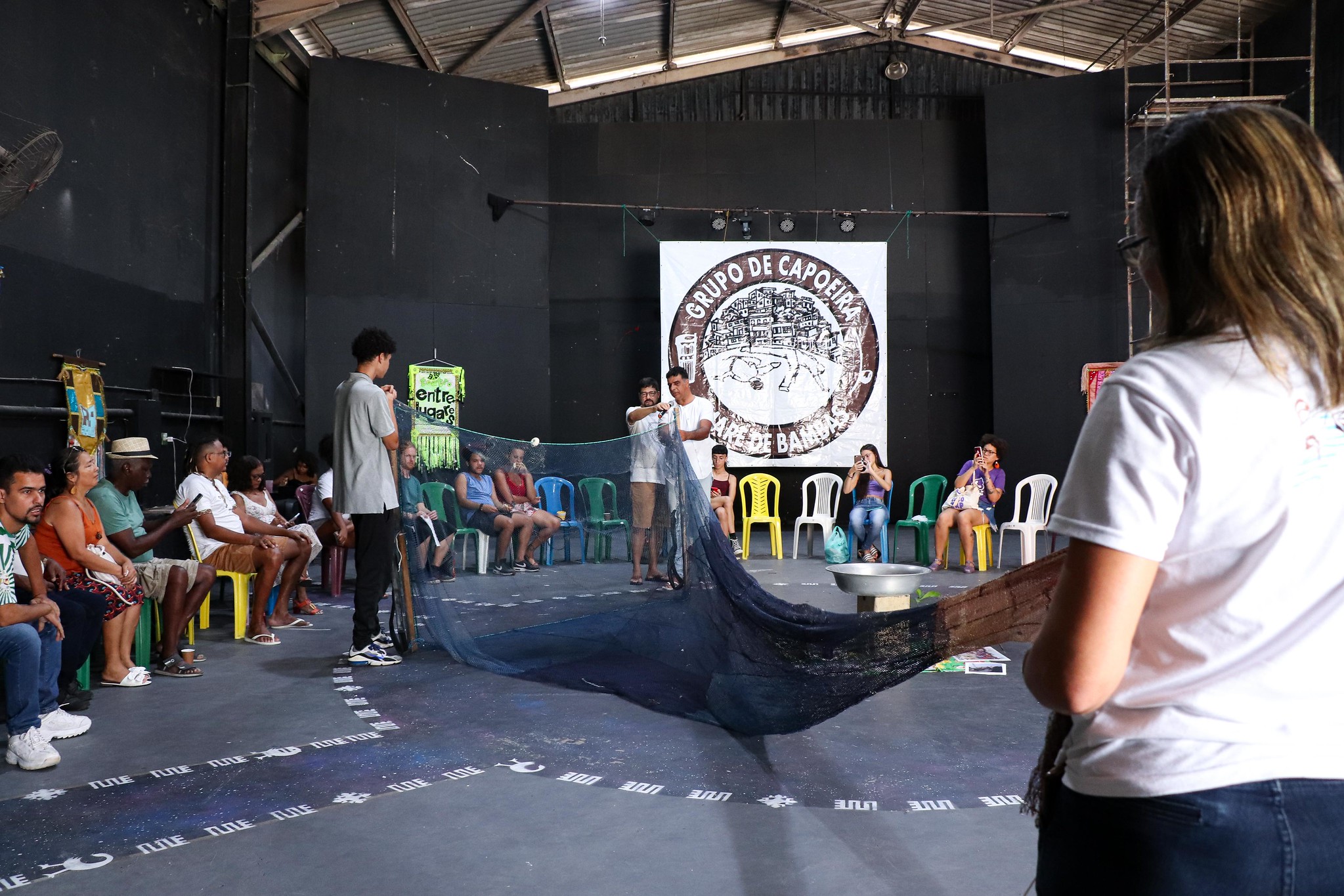
There were many more extremely significant accounts, such as the talk by Edilene Nascimento, a representative from the Vila do Pinheiro Fishermen’s Association (APEMAR). She brought reflections on the challenges faced by fishermen in their daily activities, such as their difficulty in accessing the Cunha Channel due to the large amount of garbage in the mangrove swamp. Environmental racism prevails, as the lack of action from public authorities to clean up and restore the area is “justified” due to the community being seen as a “risk area”.
“The fishermen sometimes spend over two or three hours trying to access the association. The mangrove is rich and beautiful, but with mangrove roots all full of garbage. When the tide rises, there’s a lot of garbage, I’ve already made some videos. But there is no help from the government. Nobody wants to enter the area to do this clean up work because they claim it is a risk area.” — Edilene Nascimento
Nascimento shared their history of demanding action from the government: the presentation of projects and solutions proposed by the association, attempts to access resources, and attempts to partner with the Federal University of Rio de Janeiro. But neglect of the area continues. She ended by highlighting the importance of mangroves for the quality of life of those living by the Guanabara Bay.
“When this treatment takes place, when the mangroves are revitalized, the fishermen and the animals aren’t the only ones to benefit: the mangroves do as well. They bring improvements to the environment [in general]… they improve the quality of oxygen. So, we have something rich around us, which could be well cared for… [but] neglect by the appropriate agencies… is neglecting [this favela ecosystem].” — Edilene Nascimento
How Did the Occupation of the Favela Take Place and What is the Area’s Relationship With the Climate and Nature?
The second conversation circle followed with the theme “How was the favela settled and what is the area’s relationship with the climate and nature?” The conversation largely reflected on how the historical process of Rio de Janeiro’s formation as a city was fundamental for the construction of Complexo da Maré and the infilling between the islands and coves that constituted Maré.
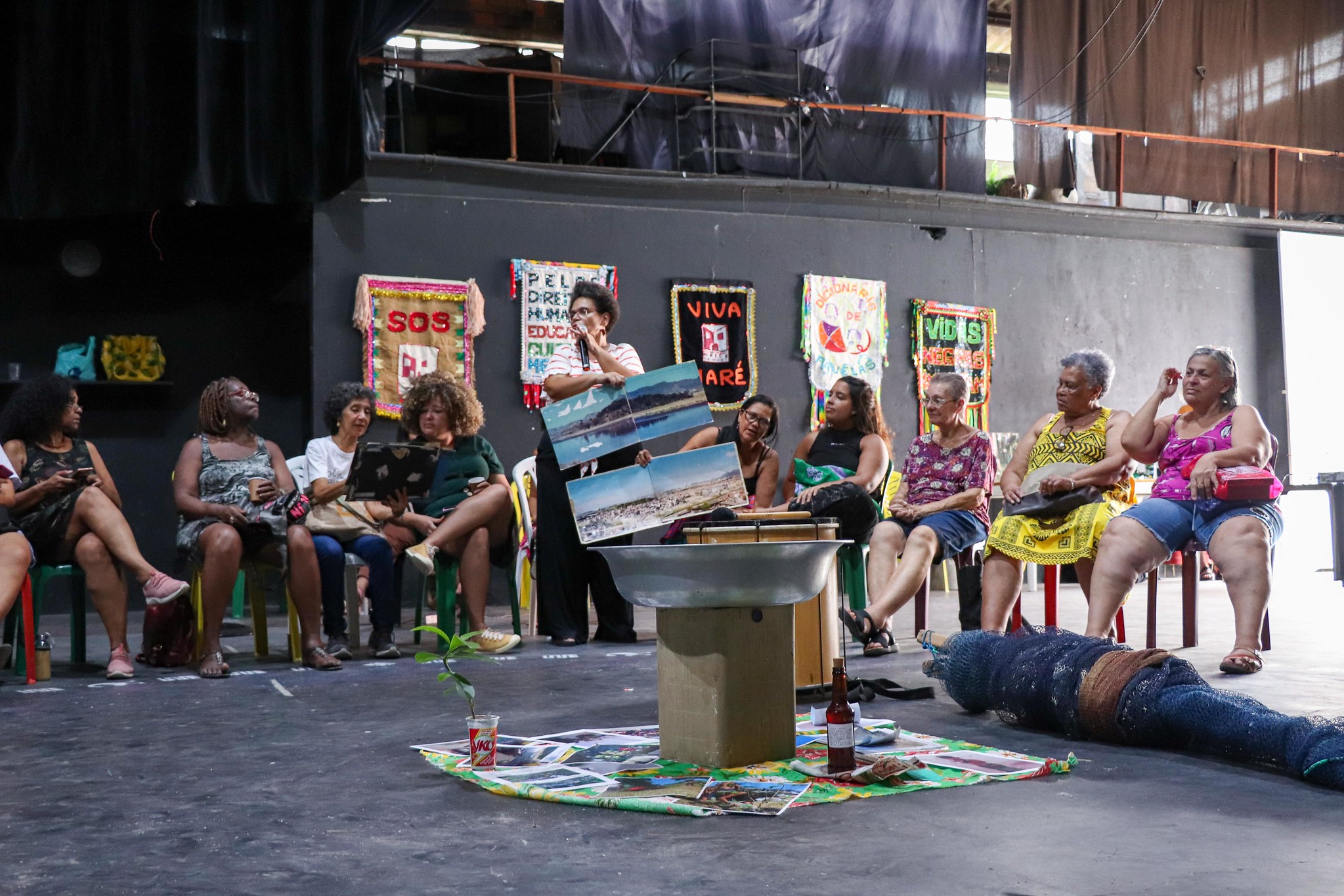
Claudia Rose Ribeiro, coordinator of the Maré Museum, reminded those present that the history of the process of forming the favelas of Complexo da Maré is recorded in images and representations in the museum.
“[Our collection] shows this whole process and how the government intervenes without planning… [without] respecting the environment… like what happened in the construction of the UFRJ University City located on Ilha do Fundão. In fact, Ilha do Fundão was a smaller island, an archipelago, with several islands. There was a project to connect these various islands by bridges, but [President] Getúlio Vargas had everything filled in and made into a single island. So, we see the extent to which government actions are the ones that affect people’s lives the most… It’s not favela residents who fill in land and dump sewage in the rivers… which directly affects the environment and will generate these climate changes.” — Claudia Rose Ribeiro
Still speaking on the role played by public authorities in producing the negative environmental impacts suffered by Maré throughout its history, Luiz Carlos Santiago recalled the natural beauty that used to surround Maré and the formerly clean waters of the Cunha Channel and the Guanabara Bay.
“This place used to be beautiful, there used to be islands here… then, they put a refinery nearby and started dumping oil into the river where we swam, where people fished… It’s like, if you’re poor, you have to live near the dump… If you’re poor, you have to live near pollution… Why is it that there’s always trash near poor people?… All the beaches here in Fundão used to be suitable for swimming. So, what started then? Pollution started on these beaches too. They started to dump oil from [the refinery] right in the middle, putting an end to everything there was… they ruined Praia de Ramos, a beach that the entire North Zone went to… There was another beach on Ilha do Governador, Jardim Guanabara, [where] the water was very clean. What happened there? We already know… None of this happened by chance… This is planned… So, we need to understand that when the government says ‘Look, we’re going to do an intervention in Maré,’ everyone has to get together and ask, ‘But what kind of intervention? How are you going to affect our lives?’… [Only] we know the changes that we need.” — Luiz Carlos Santiago
The memories on display at the museum come to life in the talks by Maré residents. Valdirene Militão, an artist who applies recycling and reuse of materials in her work, is a resident of Roquete Pinto, one of the favelas of Complexo da Maré. She shared memories of the removal of stilt houses in the region, the infilling of the area, and childhood memories at Ramos beach. She also drew attention to the importance of acting locally.
“When we think about the macro, we do want to write a letter, we do want to make changes. But we also need to think on a small scale. Really, we’re talking about [taking] responsibility [for our own area].” — Valdirene Militão
How do Climate and Environmental Issues Relate to Housing Rights and Access?
The third discussion circle, focused on the question “how do climate and environmental issues relate to housing rights and access?,” began with remarks by Maria da Penha Macena, a community leader from Vila Autódromo, who spoke of the extent to which the histories of how different Rio favelas formed share similarities, and how their fate was strongly shaped by class prejudice, structural racism, and State negligence.
“They don’t want us to live well. Why did they want to take me out of my community? Because I lived on the shore of the Jacarepaguá lagoon. In the future, 60 buildings will be built there, inside the Olympic Park… And they didn’t want poor people living there, because we poor people can serve [them], but we can’t be [their] neighbors.” — Maria da Penha Macena
Circle facilitator Victoria Alves, member of the Raízes da Mata collective and coordinator of Cocôzap Maré, denounced environmental racism in the favelas.
“All of this… really refers to… the issue of environmental racism. We are talking about the environment, but we are also talking about a social structure. We are talking about the non-implementation of public policies… which here in Maré happens in one way and, in downtown Rio, another.” — Victoria Alves
In this sense, the importance of social museology in preserving memories and the history of struggle in the favelas has gained prominence. It is, in essence, a cultural phenomenon that stimulates self-esteem and community pride, in addition to systematizing knowledge about self and place.
“An opportunity for us to tell our own stories, as poor people, as people living in the favelas, as Black people. So, we become a huge network. This is essential so that we can continue with this strength, one answering to the other, one knowing the other. This culture goes on shaping us and shaping young people so that we can have a better future, a fairer society and demand our rights, resist and stay in our locations, with great pride in being from the favelas, being Black and indigenous.” — Maria da Penha Macena
What Knowledge Has the Community Already Developed to Respond to the Challenges Posed by Nature and Climate Change?
In the final circle, facilitated by Valdirene Militão, participants shared experiences and knowledge of historical solutions and current initiatives in Maré that address issues raised by natural risks and climate change. Lorena Froz dos Santos was born and raised in Maré and is an environment technician and founder of Projeto Faveleira, which works with communication and environmental education on social media. She highlighted some current environmental projects in the favelas of Maré, such as Raízes da Mata, a collective that works to revitalize the Cadu Barcellos Ecological Park, formerly Maré Ecological Park, and Muda Maré, a UFRJ community outreach project aimed at developing research related to environmental issues.
The 2022 community initiative “There’s a new climate going on in Maré” was also remembered. Maré collectives, leaders, and residents gathered in the neighborhood performance space and prepared the Maré Climate Rights Charter, which discusses environmental racism and the fight for climate rights.
Biology teacher Jefferson Silva highlighted the Recycling Solidarity project, which operated over a long period reaching youth from Maré’s Conjunto Esperança through to Kelson’s favela. Youth participants received a stipend, had training on environmental education and recycling, generated income, and acted as multipliers in their favelas.
This and other projects with an environmental impact were brought to the community by Maria José da Silva, known as Zezé, founder of the Conjunto Bento Ribeiro Residents Association. She went on to speak about the importance of combining the diagnostics gathered by collectives with the writing of project proposals and search for resources to get each project off the ground and produce concrete actions that attend to existing demands.
Closing the day, host Antonio Carlos Vieira from the Maré Museum established an important reflection on the favela formation process. For him, the stilt house is the greatest symbol of solutions for the survival of people in Maré, an ancestral technology.
“It’s not by chance that there’s a stilt house at the center of the museum. The stilt house is a survival strategy, knowledge, it’s technology to deal with the natural phenomenon of the tide, over which you have no control [and for which Maré is named]… Today, we walk around this neighborhood and it’s marshy land that was filled in, but people came to live here when very little was dry land. Most of the houses were built above the tide, over the water… The houses weren’t lightweight; they needed to have a sturdy structure because the roofs were made of mud. In general, if you look at the photos in the museum, you’ll see that most of the houses were made of mud… It’s a very heavy load. So, that right there, is a genuine work of engineering. I think we cannot lose sight of the fact that this knowledge is a symbol, it is a reference that we have here in Maré.” — Antonio Carlos Vieira
Read the entire series of reports on the Favela Climate Memory project.
Don’t miss the album of Maré’s climate memory circle below (or click here to see it on Flickr):
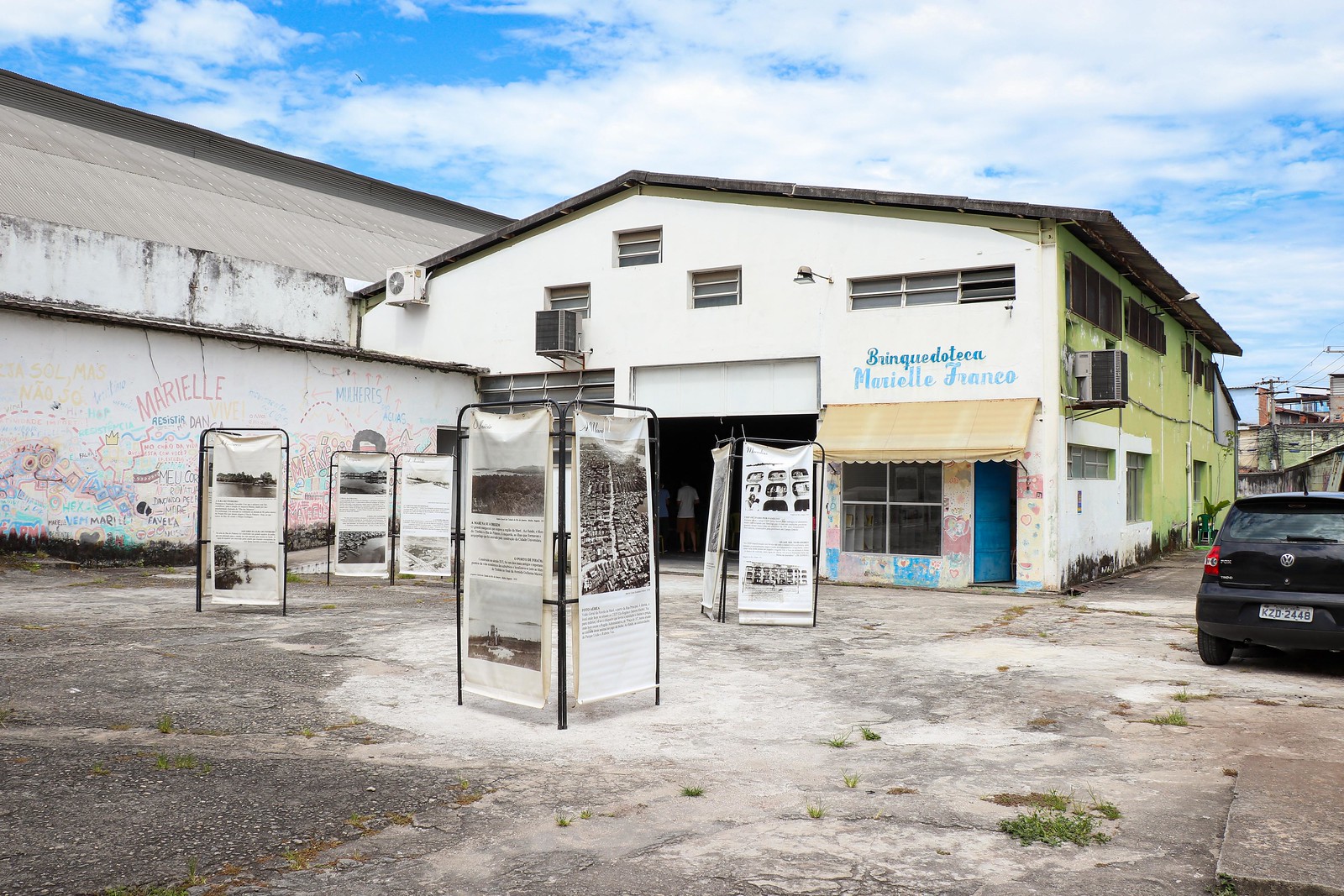
*The Sustainable Favela Network (SFN) and RioOnWatch are projects of Catalytic Communities (CatComm).
